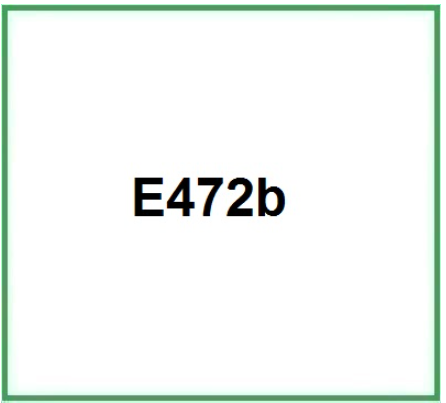E472b, also known as Lactic Acid Esters of Mono- and Diglycerides, is an emulsifier used in the food industry to improve the texture and stability of various products. It is produced by reacting mono- and diglycerides of fatty acids with lactic acid, creating a compound capable of emulsifying fats and water, enhancing the structure and shelf life of food products. This additive is commonly used in baked goods, spreads, and other processed foods.
Chemical Composition and Structure
Lactic acid esters of mono- and diglycerides are formed when lactic acid reacts with mono- and diglycerides of fatty acids, which are derived from vegetable oils or animal fats. Their chemical structure allows them to stabilize emulsions between water and oil-based ingredients, maintaining homogeneity and improving texture in food products.
Physical Properties
E472b typically appears as a viscous liquid or waxy mass, depending on the formulation. It is partially soluble in water but highly effective at binding water and fats, forming stable emulsions. Due to these properties, it is widely used in food products that require long-lasting and uniform emulsions.
Production Process
E472b is produced by the reaction of mono- and diglycerides of fatty acids with lactic acid. The fatty acids used to produce the mono- and diglycerides may be sourced from vegetable or animal origins. The final product is an emulsifier capable of maintaining stable mixtures of fats and water.
Raw Materials and Their Functions
Fatty Acids derived from vegetable oils or animal fats, fatty acids are used as the base for the production of lactylates.
Lactic Acid. An organic acid used to react with fatty acids to form lactylates.
Industrial Chemical Synthesis of E472b
- Esterification of fatty acids with lactic acid. During this reaction, ester bonds are formed between the fatty acids and lactic acid, producing lactic acid esters of fatty acids.
- Reaction Control. The esterification reaction is monitored to ensure it occurs correctly and the final product has the desired properties.
- Purification. After the reaction, E472b is purified to remove impurities and by-products.
- Quality Control. The purified E472b undergoes quality checks to ensure it meets the required standards. After quality control, it is packaged for use in food products as an emulsifier and stabilizer.
Form and Color
E472b, is typically a waxy solid or a paste usually white or slightly yellowish.

What it is used for and where
Food
Ingredient included in the list of European food additives as E472b, emulsifier and stabilizer used by the food industry.
The complete list E472 Esters of mono- and diglycerides:
- E472a : Acetic acid esters of mono- and diglycerides
- E472b : Lactic acid esters of mono- and diglycerides
- E472c : Citric acid esters of mono- and diglycerides
- E472d : Tartaric acid esters of mono- and diglycerides
- E472e : Diacetyltartaric acid esters of mono- and diglycerides
- E472f : Mixed esters,tartaric, acetic of mono- and diglycerides
Health and Safety Considerations
Safety in Use
E472b is considered safe for use in food and is approved by various international regulatory bodies such as the European Union and the Food and Drug Administration (FDA) in the United States. No significant side effects are associated with its use at the recommended levels.
Excessive intake of emulsifiers such as E472b may be associated with high risks of cardiovascular diseases (CVD) (1).
Allergic Reactions
Allergic reactions to E472b are very rare, though they may occur in individuals sensitive to ingredients used in the production of mono- and diglycerides, such as soy or animal fats. People with known allergies should check product labels.
Toxicity and Carcinogenicity
It is widely used in processed foods and considered safe within the approved concentrations in food products.
Environmental and Safety Considerations
E472b is derived from natural sources such as vegetable oils or animal fats, making it biodegradable with a low environmental impact. However, the sustainability of the fatty acid sources may vary, so it is important to ensure they are sustainably sourced.
Regulatory Status
E472b is approved as a food additive in many regions, including the European Union, where it is classified as E472b, and the United States, where it is regulated by the FDA. It is used within specific limits to ensure consumer safety.
References__________________________________________________________________________
Sellem L, Srour B, Javaux G, Chazelas E, Chassaing B, Viennois E, Debras C, Salamé C, Druesne-Pecollo N, Esseddik Y, de Edelenyi FS, Agaësse C, De Sa A, Lutchia R, Louveau E, Huybrechts I, Pierre F, Coumoul X, Fezeu LK, Julia C, Kesse-Guyot E, Allès B, Galan P, Hercberg S, Deschasaux-Tanguy M, Touvier M. Food additive emulsifiers and risk of cardiovascular disease in the NutriNet-Santé cohort: prospective cohort study. BMJ. 2023 Sep 6;382:e076058. doi: 10.1136/bmj-2023-076058. PMID: 37673430; PMCID: PMC10480690.
![]() E472b
E472b 


